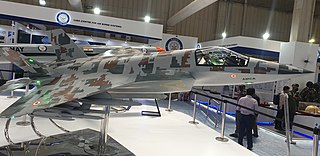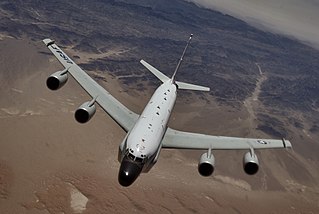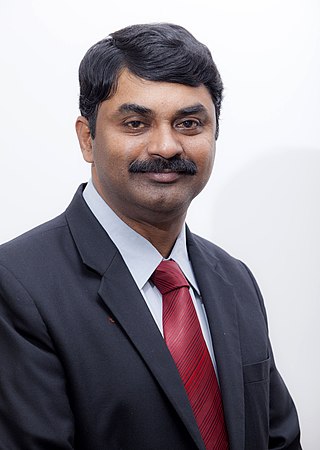Related Research Articles

The Defence Research and Development Organisation (DRDO) is the premier agency under the Department of Defence Research and Development in Ministry of Defence of the Government of India, charged with the military's research and development, headquartered in Delhi, India. It was formed in 1958 by the merger of the Technical Development Establishment and the Directorate of Technical Development and Production of the Indian Ordnance Factories with the Defence Science Organisation under the administration of Jawaharlal Nehru. Subsequently, Defence Research & Development Service (DRDS) was constituted in 1979 as a service of Group 'A' Officers / Scientists directly under the administrative control of Ministry of Defence.

The HAL Tejas is an Indian single engine, delta wing, light multirole fighter designed by the Aeronautical Development Agency (ADA) in collaboration with Aircraft Research and Design Centre (ARDC) of Hindustan Aeronautics Limited (HAL) for the Indian Air Force and Indian Navy. It was developed from the Light Combat Aircraft (LCA) programme, which began in the 1980s to replace India's ageing MiG-21 fighters but later became part of a general fleet modernisation programme. In 2003, the LCA was officially named "Tejas". It is the smallest and lightest in its class of contemporary supersonic combat aircraft.

An active electronically scanned array (AESA) is a type of phased array antenna, which is a computer-controlled array antenna in which the beam of radio waves can be electronically steered to point in different directions without moving the antenna. In the AESA, each antenna element is connected to a small solid-state transmit/receive module (TRM) under the control of a computer, which performs the functions of a transmitter and/or receiver for the antenna. This contrasts with a passive electronically scanned array (PESA), in which all the antenna elements are connected to a single transmitter and/or receiver through phase shifters under the control of the computer. AESA's main use is in radar, and these are known as active phased array radar (APAR).

Rajendra is a passive electronically scanned array radar developed by the Defence Research and Development Organisation (DRDO). It is a multifunction radar, capable of surveillance, tracking and engaging low radar cross section targets. It is a ground surveillance radar and is a great source of surveillance operating at frequency around 20 GHz. It is mainly used to track enemy's installations.

The HAL Advanced Medium Combat Aircraft (AMCA) is an Indian programme to develop a fifth-generation stealth, multirole combat aircraft for the Indian Air Force and the Indian Navy which will also include sixth-generation technologies. The design of the aircraft is carried out by Aeronautical Development Agency (ADA) of Defence Research and Development Organisation (DRDO). It is expected to be produced by a public-private joint venture between the DRDO, Hindustan Aeronautics Limited (HAL), and an Indian private company. The development cost is estimated to be around ₹15,000 crore.
Bharat Electronics Limited (BEL) is an Indian Government-owned aerospace and defence electronics company. It primarily manufactures advanced electronic products for ground and aerospace applications. BEL is one of sixteen PSUs under the Ministry of Defence of India. It has been granted Navratna status by the Government of India.
Defence Electronics Research Laboratory (DLRL) is a laboratory of the Defence Research & Development Organization (DRDO). Located in Hyderabad, it is actively involved in the design and development of integrated Electronic Warfare systems for the Indian Armed Forces.

Signals intelligence operational platforms are employed by nations to collect signals intelligence, which is intelligence-gathering by interception of signals, whether between people or between machines, or mixtures of the two. As sensitive information is often encrypted, signals intelligence often involves the use of cryptanalysis. However, traffic analysis—the study of who is signalling whom and in what quantity—can often produce valuable information, even when the messages themselves cannot be decrypted.
The Centre for Airborne Systems (CABS) is a laboratory of the Defence Research and Development Organisation (DRDO) of India. Located in Bengaluru, its primary function is development and evaluation of airborne electronic systems for military applications.
The Airborne Surveillance Platform (ASP) is an Indian defence project initiated by the Defence Research and Development Organisation (DRDO) with the aim to produce an Airborne Early Warning System. Two prototypes were developed and flight tested for three years. The project was cancelled in 1999 after the prototype aircraft crashed, killing eight scientists and the aircrew. After four years of inactivity, the project was revived in 2004 with a new platform and radar.
Samyukta is a mobile integrated electronic warfare system. Touted to be the largest electronic warfare system in India, it was developed jointly by DRDO, Bharat Electronics Limited, Electronics Corporation of India Limited, and Corps of Signals of Indian Army. The System is fully mobile and is meant for tactical battlefield use. It covers wide range of frequencies and coverage of electromagnetic spectrum is handled by the communication segment and the non-communication segment. Its functions include various ELINT, COMINT and electronic attack (ECM) activities.
Electronics and Radar Development Establishment (LRDE) is a laboratory of the Defence Research & Development Organisation (DRDO), India. Located in C.V. Raman Nagar, Bengaluru, Karnataka, its primary function is research and development of radars and related technologies. It was founded by S. P. Chakravarti, the father of Electronics and Telecommunication engineering in India, who also founded DLRL and DRDL.

The DRDO Airborne Early Warning and Control System (AEW&CS) is a project of India's Defence Research and Development Organisation to develop an airborne early warning and control system for the Indian Air Force. It is also referred to as NETRA Airborne Early Warning and Control System (AEW&CS).

A missile approach warningsystem (MAW) is part of the avionics package on some military aircraft. A sensor detects attacking missiles. Its automatic warning cues the pilot to make a defensive maneuver and deploy the available countermeasures to disrupt missile tracking.
The Indian Air Force has been undergoing a modernization program to replace and upgrade outdated equipment since the late 1990s to meet modern standards. For that reason, it has started procuring and developing aircraft, weapons, associated technologies, and infrastructures. Some of these programs date back to the late 1980s. The primary focus of current modernization and upgrades is to replace aircraft purchased from the Soviet Union that currently form the backbone of the Air Force.

G. Satheesh Reddy is the Scientific Adviser to Raksha Mantri, leading India's indigenous development of defence systems and technologies. He has worked on the development of missiles, fighter aircraft, unmanned aerial defence systems, and radar systems.

Uttam is a solid-state gallium arsenide (GaAs) based active electronically scanned array (AESA) radar under development by the Electronics and Radar Development Establishment (LRDE), a laboratory of the Indian Defence Research and Development Organisation (DRDO). It is a low probability of intercept radar intended to be installed on the HAL Tejas Mark 1A, HAL Tejas Mark 2 and HAL TEDBF aircraft with plans to implement a larger and more powerful variant on-board India's 5th Generation fighter aircraft, HAL AMCA.
Samtel Avionics is an Indian company headquartered in Delhi. It manufactures equipment and systems for avionics, military, industrial, and professional applications. Samtel Avionics is a subsidiary of the Samtel Group.

The HAL Tejas Mark 2, or Medium Weight Fighter (MWF), is an Indian single-engine, canard delta wing, multirole combat aircraft designed by the Aeronautical Development Agency (ADA) in collaboration with Aircraft Research and Design Centre (ARDC) of Hindustan Aeronautics Limited (HAL) for the Indian Air Force (IAF). It is a further development of the HAL Tejas, with an elongated airframe, close coupled canards, new sensors, and a more powerful engine.
This article consists of projects of the Defence Research and Development Organisation.
References
- 1 2 "DARE - Director's Profile". www.drdo.gov.in. Retrieved 30 May 2019.
- ↑ "Inaugural naval flight test seminar held at Goa". The Economic Times. 20 September 2018. Retrieved 30 May 2019.
- ↑ "Defence Avionics Research Establishment". SIGNAL Magazine. Retrieved 30 May 2019.
- ↑ Warrier, B. S (8 October 2012). "A flypast of warfare and mission avionics". The Hindu. ISSN 0971-751X . Retrieved 30 May 2019.
- 1 2 "Historical Background". Ministry of Defence (India) . Retrieved 7 June 2019.
- ↑ Gokhale, B. N. (October 2011). "Electronic Warfare - War Without Weapons". SP's Aviation. SP Guide Publications.
- 1 2 John, Knowles (February 2009). "Charting the Course of Indian EW". Journal of Electronic Defense. 32 (2): 26–30. ISSN 0192-429X.
- ↑ "Combat Aircraft Computer Ready". India Abroad. Vol. XXII, no. 5. New York: India Abroad Publications. 1 November 1991. p. 10. ISSN 0046-8932.
- ↑ Majumdar, Sayan (September–October 2014). "Tejas Redux: The Israeli Touch". Vayu Aerospace and Defence Review. No. 5. Society for Aerospace Studies. pp. 82–84.
- ↑ Zord, Gábor; Goodman, Glenn (June 2009). "Protecting the World's Fighter Aircraft". Journal of Electronic Defense. 32 (6): 28–42. ISSN 0192-429X.
- ↑ Fiszer, Michal (April 2005). "Indian Su-30MKIs Nearly Ready". Journal of Electronic Defense. 28 (4): 20–22. ISSN 0192-429X.
- ↑ Richardson, E (August 2006). "INDIA AND EADS TO DEVELOP MISSILE WARNING SYSTEM". Journal of Electronic Defense. 29 (8): 23. ISSN 0192-429X.
- ↑ Zord, Gábor (July 2008). "Europe's Emerging EW Needs". Journal of Electronic Defense. 31 (7): 32–42. ISSN 0192-429X.
- ↑ Shukla, Ajai (17 December 2018). "Indigenous electronic warfare system ignored for IAF's Tejas aircraft" . Business Standard.
- ↑ "Report of the Comptroller and Auditor General of India for the year ended March 2014: Union Government (Defence Services) Air Force No. 38 of 2015" (PDF). cag.gov.in. Comptroller and Auditor General of India. p. 134.
- ↑ "'A Globally Competitive Aerospace Industry'". Military Technology. Vol. 28, no. 7. Bonne: Mönch Publishing Group. July 2004. pp. 90–92. ISSN 0722-3226.
- ↑ "On the Radar". Aviation Week & Space Technology. Vol. 172, no. 38. New York: Informa. 18 October 2010. p. 51. ISSN 0005-2175.
- ↑ Waldron, Greg (12 January 2015). "Tejas tests Indian-made EW suite". Flightglobal.com.